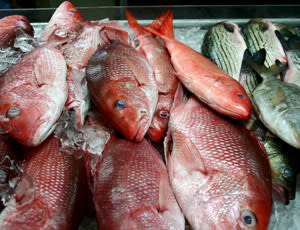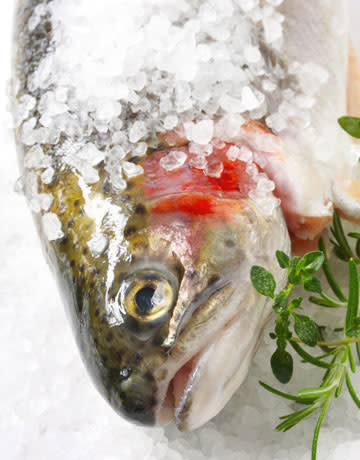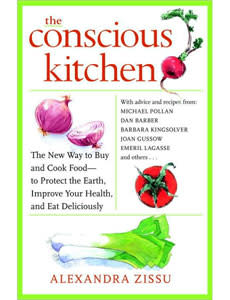How to Find Safe, Sustainable Fish
As a longtime The Daily Green blogger, on the occasion of the publication of my second book, The Conscious Kitchen, I'm using my "Ask An Organic Mom" space for the next 8 weeks give or take to invite you to join me on the Conscious Kitchen Challenge.
What does it mean to have a Conscious Kitchen? It's a little different for every person, but at its heart, it means knowing where your food comes from, what it is, and how good it is (or isn't) for you and for the environment. It also encompasses the energy it takes to cook, what you're cooking on and storing food in, and even how you clean up and handle waste.
We all know we need to be eating better foods local, organic, local and organic, humanely raised meat, wild and well-caught fish, packaged foods containing five pronounceable ingredients or less but they're not always so easy to find. Or it's not always so easy to motivate to find them. Think of this like you think of New Year's resolutions. Choose your own personal goal make it attainable for better success and then together we'll methodically get you there. Keep in mind that any conscious steps are better than no conscious steps 10 percent is better than no percent.
Week 1: The Kitchen Self-Exam
Week 2: Food Shopping
Week 3: Fruits and vegetables
Week 4: Meat
Week 5 Challenge: Fish
The Issues
I write this post with a heavy heart. I cannot think of fish right now without thinking of the Gulf Coast oil disaster, including what that is doing to aquatic life and the fishing industry. Who knows at this point how wide reaching the repercussions will be. But it's devastating on just about every level.
Seafood has always been a tough topic for me. The wild versions are woefully contaminated, as our waterways are the runoff basin for all of the environmentally destructive activities we humans do (mercury from power plant emissions, PCBs that were banned so many years ago but still linger, hormone disruptors from the cosmetics we wash down the drain), and the farmed fish are very similar to factory-farmed animals. I would never willingly eat the crap they feed the fish including hormones, antibiotics and dyes so I don't eat the fish that eat it. To top it all off, eating locally something I try to do a lot of can be particularly difficult if your local waterways are known to be contaminated, which mine are. Further complicating things, 80 percent of the fish in the US is imported from Central America and Asia, where regulations are iffy. Their wild stuff tends to be fished in ecologically destructive ways, and the farmed stuff usually raised in what are essentially sewage pits. No thank you.
Knowing all this I have always had a hard time telling people who want to eat seafood what they can safely eat. I skirted the topic as much as possible in my first book, The Complete Organic Pregnancy, only talking about contaminants to avoid when pregnant. So I made seafood my own challenge to really tackle for The Conscious Kitchen. By and large I feel I succeeded. It wasn't easy (ask my editor!), but I'm more comfortable now than I have ever been with the seafood I eat. Overall it's still fraught, because we're still polluting and harvesting unsustainably, and we haven't cracked the code on the right ways to farm fish. If we could all eat the Spanish fish that Dan Barber highlighted in his Ted talk (right), that would be lovely, especially if it were local. But the sad fact remains that if you want to eat seafood consciously, you have some navigating to do. Here's how to do it.
Research Before You Shop
When it comes to seafood, doing a little research before you shop is essential. Start by making a list of the fish you currently like to eat, and researching them. Are they very contaminated? Are they overfished? How are they being fished (hook and line is far better than trawls which are better than dynamite)? If farmed, what are they being fed and how and where are they being farmed. Some farmed fish are fed wild fish ground up this is not only unsustainable, it takes natural feed away from bigger wild fish, and contaminates farmed fish with PCBs and more.
The goal here is to wind up with five eco-and health-ok choices. Then, the next time you find yourself at a fish counter or at a restaurant about to order seafood, you can mentally fall back on those five choices you know something about. And feel safe choosing them.

Where To Research
I have a long list of resources to turn to in The Conscious Kitchen. Many safe seafood guides are put together by ocean and water conservancy groups and offer cheat sheets you can download and tuck into your wallet or databases you can search on your phone as you shop. There are even services you can text while shopping or reading a menu they instantly send you back the environmental and health concerns for any given fish. Poke around online and get to know the guides. Each one has different slant some are more geared towards saving the waterways, others towards protecting pregnant mothers and young children from toxins found in seafood that interfere with brain development. My research has lead me to believe that the best seafood options out there are sustainable wild, well caught, and eaten in moderation.
Photo: Philip Sasser/Istock

Shop
Once you have your list of five, go shopping. Stack the cards in your favor: frequent fishmongers and farmers markets where you can ask question and get good answers. If you live in an area that is highly contaminated, ask the fishermen for their take on what's safe and what isn't. Contrast this with your own research. The government has recommendations for how much of a contaminated fish is safe to eat and at what phase of life pregnant moms and young kids are supposed to avoid eating too much of the most toxic fish. I suggest being even more stringent and avoiding the truly polluted seafood entirely. There are also supermarkets known to do a better job sourcing safe seafood than others. Greenpeace ranks them yearly. Another option is to join a CSF Community Supported Fishery. This is like a CSA but for seafood. I belong to one in Maine.
Photo: Sam Roberts/Getty Images
A Word On Organic
Normally I suggest people look for that USDA organic stamp, but there's no such thing as "organic" fish. Certification standards have been in the works for a long time, but there are serious hurdles. First off, you cannot certify something that is wild. So if and when the standards happen, they will only be for farmed seafood. But because farmed seafood is often fed wild fish, the feed wouldn't be able to be certified. Sticky situation. The industry finds the standards impossible, and environmentalists don't like the idea of fish farming at all, as it can pollute the waterways. I'm staying tuned to see what the standards board manages to come up with. In the absence of USDA organic, surprisingly there aren't many third party certifiers of sustainable fisheries other than Marine Stewardship Council certified fish MSC.org. Look for their label.

Omega 3s and Fish That Don't Swim Near You
Salmon doesn't swim in the waters near me. I don't actually like the flavor so this isn't an issue for me. The environmental degradation of flying something across the country or the world may not be worth it to you. But if you love it, and want to be getting the nutritional goods that certain non-local fish contain, shop wisely. I have resources in The Conscious Kitchen for sustainable wild salmon and well-caught tuna, plus canned versions that are both sustainable and come in cans not lined with BPA.
Photo: Robyn Mackenzie/Istock
Act Up
The only way to eat safe seafood is to protect our waterways. Let your politicians know you want cleaner waterways, stronger regulations, and better labeling. You can contact them directly or join forces with the same environmental groups that maintain the online databases where you'll research your top five seafood choices.
Next post, we'll move onto beverages. Meanwhile, I'm curious to know how you're faring. Let me know in comments. Any questions? Put them there as well. Or, if you happen to be in the New York area, come ask me in person. I'm doing several Conscious Kitchen events in the next few weeks. Find them at www.alexandrazissu.com/events.
The Conscious Kitchen: The New Way to Buy and Cook Food - to Protect the Earth, Improve Your Health, and Eat Deliciously is an invaluable resource filled with real world, practical solutions for anyone who has read The Omnivore's Dilemma or seen Food, Inc. and longs to effect easy green changes when it comes to the food they buy, cook, and eat.
posted by Alexandra
Reprinted with Permission of Hearst Communications, Inc.

